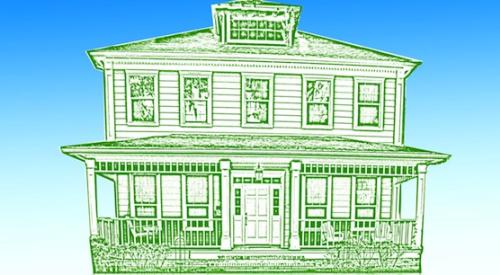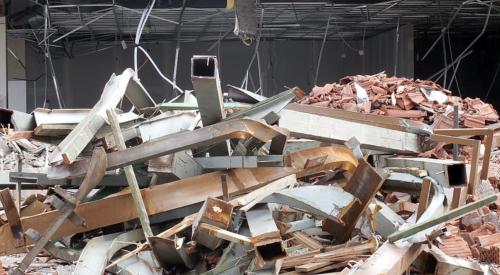|
Large volume production builders make no secret of their aversion to risk. They approach any new building system, product or method with caution. One mistake repeated thousands of times can cost millions.
That may explain why, according to a new study released by the Partnership for Advancing Technology in Housing (PATH), half of all production builders surveyed say they urge home builders to "stick with tried and true" materials and products. Nearly half (48 percent) say they "like to wait until other builders have successfully offered new building and construction products."
"The barriers to innovation are enormous," explains Mark Hodges, vice president of corporate communications for K. Hovnanian Homes, based in Red Bank, N.J. "There's difficulty with local code officials, difficulty in implementation and finally, reliance on the performance of unskilled craftsman who often speak different languages on the job site."
Randy Luther, vice president of construction technology for Dallas-based Centex Homes, agrees. He says there's no "magic bullet" product likely to change the business overnight.
"We keep monitoring the PATH stuff, hoping for the Holy Grail to come along," Luther says "but it hasn't happened. Typically the rubber meets the road once we get into the research. That's where we look at products ourselves. We do a lot of independent testing."
Despite all the obstacles, Hovnanian and other firms continue to inch forward with new products and systems; every builder has a different system for auditing promising technology. Hovnanian, for example, just created a new position for a full-time building science expert.
Other firms such as Pulte have created research and development departments, but these are still the exception, not the rule. Some rely on informal committees or partners for feedback on new products. Many look to their subcontractors to suggest changes. Still others simply wait for problems to show up before making changes.
Stuart McDonald, vice president of operations for Mercedes Homes, based in Melbourne, Fla., looks for feedback on promising new products and systems from a group of eight independent partners, including Steven Winter Associates of Norwalk, Conn., and the Building Science Corp. in Westford, Mass.
"We might even get FEMA on the line," he adds. "We'll ask what people have heard about a product, and then start some testing on it."
Larger builders often construct a complete prototype to test new products. For example, Mercedes Homes is exploring a new structural system comprising two-story cast-in-place concrete walls poured into reusable aluminum forms.
"We went into a neighborhood and built a prototype," McDonald explains. "Some stuff works perfectly when it's in pieces, but we need to know if it works when you add the paint, put a roof above it — if it still performs."
Motivating FactorsUnderstandably, many production builders still question the payback from innovation. Why pursue new products when the old ones seem to be working fine?
"The constant chasing of cost reductions is a big driver," notes Steven Winter, president of Steven Winter Associates. "They're constantly on the prowl for better ways to do things, but it's cut costs, cut costs, cut costs — their bonuses, everything is so dependent on it."
The PATH study, however, suggests that directly cutting costs is not the only motivator for builders. They also have a keen interest in the indirect benefits of innovation — from reducing callbacks to lowering maintenance to setting their brand apart.
As an example of a troubleshooting-driven innovation, Winter cites research on the use of buried duct technology at Mercedes Homes in Florida. "You're putting cooling ducts in attics that are getting up to 180 degrees," he notes. "So buried ducts make a lot of sense — both from an energy standpoint and to avoid problems."
Winter and his firm's senior architect, Bill Zoller, also helped Mercedes find the reusable aluminum forms that have become an important cost-saver for their cast-in-place wall.
High Hurdles  |
It's not without good cause that production builders exercise caution before making a big innovation move. In the past, they have been burned by products such as polybutylene plumbing, hardboard siding and fire retardant plywood that delaminated and failed.
"Our experience with that plywood 15 or 20 years ago has affected us profoundly," says Hodges. "We ended up replacing thousands of roofs at a cost of millions of dollars. We changed the way we went about innovating — there's no way we will try out a brand new product somebody has only tested in a lab."
It's not just the past that haunts production builders with regard to innovation. They also face the triple hurdle of detached manufacturers, purchasing agents with a "stay the course" agenda, and laborers who are both reluctant to change and all over the map in terms of skill level.
Hurdle: Manufacturer DisconnectThe role of manufacturers in the innovation process is often underestimated — especially by the manufacturers themselves.
The PATH study notes that "given the strategic placement of manufacturers and suppliers, it is surprising that their role in innovation in the home building industry has been overlooked until very recently."
From the builder point of view, that disconnect could not be more obvious.
"Often a manufacturer's component is not treated as part of the system," adds Luther. For example, we did our own research on caulking. We found out the common form of caulking used on windows was dissolving the asphalt flashing underneath it.
"Often there's not a lot of information available on how to use innovative products," he adds, "such as how to finish off steel framing if you have to go back and make a change."
Some builders — including Centex — have begun to work aggressively with manufacturers, literally sending them back to the drawing board.
"We've become very active in identifying where we have issues with a product design. We tell them 'here's what we think,' and they respond. For instance, we've had great success with Dow foam sheathing, flashing and housewrap."
After hurricanes in Florida exposed a weakness in existing soffits, Mercedes Homes asked Alcoa to engineer a new type of soffit.
"They worked on it and came up with a new prototype that is baffled, so water doesn't blow up into the house," says McDonald.
Hurdle: Purchasing PolyannasProduction builders often rely on the corporate purchasing department to make choices on new products or technologies. The study found that at the national corporate level, purchasing departments were willing to take risks with innovation, but at the regional or local level, purchasing agents with decision-making power often put the brakes on change.
A purchase manager is not motivated to advance technologies unless they hit his bottom line," notes Hodges. "They are incentivized by cost per square foot. That's why we brought on a building science person. Now, we have someone manufacturers can go to who doesn't have a pure bricks and mortar motivation."
Hurdle: Labor FragmentationAnother major deterrent to innovation is the unpredictable and often highly transient labor force, especially among key trades such as framing. Builders such as Centex are working toward standards and conformity among the trades, but they face an uphill slog.
"When we do our audits each year," notes Luther, "we take a photo of every non-formance and send it around to all the divisions so they can fix it automatically. The framers are a classic example. Each has his own system. If you gave them a test of standard framing techniques, the failure rate would be astronomical."
Alan Mooney, president of Criterium Engineers in Portland, Maine, runs a national consulting firm that specializes in housing defect assessment. He says new products ought to be designed so that they can be installed improperly.
"The product has to be consistently executable," he explains. "A less than fully trained person who may not be proficient in English has got to be able to install it without error."
He cites drywall clips as an innovation success story. "When those came along, they literally solved the drywall cracking problem within a year or two," he recalls. "Before that technology, builder solutions were all over the map. Small builders were hand-selecting their lumber, carrying moisture meters into the yard. It wasn't working."
Hurdle: Local Code CurmudgeonsAlthough most local jurisdictions have adopted some form of the standardized building codes, the interpretation, enforcement and acceptance of those codes varies drastically. Production builders who might otherwise try a new product or system can be stymied by the any local code official — even if the practice is permissible under the International Building Code.
"Our friends at the construction codes often challenge a new system, regardless of whether it conforms to the building code," notes Hodges. "I'll give you one perfect example we experienced when trying to convert to shallow depth footings in one of our regions. Every time we went into a new town, the local code official said, not in my town."
Those shallow frost foundations have been accepted since 1995, when they became part of the Council of American Building Officials code.
"You just don't cross them," Hodges continues. "It's not worth it. Right now we've got 400 municipalities, and every one of them has its own rules. The manufacturers bring a product to meet the International Residential code and assume it's OK, and they're done. But they're not going to go to 50,000 municipalities across the country and make sure they accept that product. They can't afford to do so."
Why Take the Risk?Mooney adds that successful product integration has to involve commitment at both the corporate and the operations level.
"For the guy on the operations level it has to matter today," he explains. "He wants to avoid callbacks, to take pride in his work — that's his level. Five levels up, the issue may be litigation; this is the person who has to deal with what was done five years ago. They're different incentives, but for the same action."
The PATH study also found that commitment to innovation at the corporate level has a big impact on whether or not a company pursues new technologies at the field level. For example, McDonald encourages employees to come forward when they discover a problem-solving product or technique.
"If it's a really good idea, we present the employee with a 'Stuart McDonald Get 'er Done Award' — a little plaque with their name inscribed on it.
"We're inundated with a lot of different products," he adds, "and almost every one proclaims to be the answer to all things. We have to have a system to work through what's real."
Of course, the personal touch that works for a private firm such as Mercedes may not fly with the big public companies. Mark Hodges asserts that the very nature of home building tends to make rapid innovation highly unlikely.
"If homes were built using just five products, we could change rapidly," Hodges notes. "But a home has so many hundreds of elements and parts, that one innovation doesn't make broad leaps. We build homes more effectively today. We nail them better, and flash them better, but we still use wood, and we'll be using wood for a long time to come."
The recent downturn in the housing market may allow big builders to refocus their efforts on innovation — but, Luther says, it won't be just one product or another that gets special attention. Instead, he'll push for steady improvement of the whole home and universal construction standards that every division can follow.
And of course, there's the age old conundrum most builders face — giving the buyers what they want, at the same time investing in "behind the walls" innovations and improvements.
"Rarely do home buyers even know about a new product," Hodges says. "They're not much interested in stuff they can't see, such as flexible piping behind the walls. They're much more interested in how many colors of countertops they have. It's not that they don't care, but they assume that what you put behind the wall is leading technology."
Hodges adds that on one front, at least, consumers are taking a sudden and serious interest in innovation — saving energy. "We're seeing that on a large scale already," he says. "We've been successful in using the energy rise to drive innovation in many of our markets."
| ||||||||||||||||||||||||||||||||||||||||||||||||||||||||||||||||||||||||
|
When asked which sources keep them up-to-date on new products and systems, production builders reported more dependence from manufacturers and subs than from academic research and retail outlets.
| ||||||||||||||||||||||||||||||||||||||||||||||||||||||||||||||||||||||||
Production builders rely heavily upon manufacturers and suppliers when adopting new building products, materials and practices.
| Low importance | Average importance | High importance | |
| Suppliers | 1% | 27% | 71% |
| Manufacturers | 5% | 24% | 71% |
| Subcontractors | 7% | 23% | 70% |
| Corporate architects or engineers | 20% | 50% | 30% |
| Regional managers | 8% | 40% | 52% |
| Project/construction managers in local offices | 18% | 42% | 41% |
| Source: PATH | |||
Production builders were asked how using innovative construction products, materials and practices improved their business over the past five years.
| Low benefit | Average benefit | High benefit | |
| Decreased costs of building | 23% | 55% | 23% |
| Created image as an innovative builder | 17% | 43% | 41% |
| Increased productivity | 11% | 54% | 35% |
| Increased quality of homes built | 4% | 32% | 64% |
| Helped comply with codes and regs | 20% | 55% | 25% |
| Increased profit | 25% | 52% | 23% |
| Increased competitiveness | 17% | 38% | 45% |
| Helped meet customers' expectations | 6% | 48% | 46% |
| Reduced build time | 25% | 52% | 23% |
| Reduced callbacks | 11% | 47% | 42% |
| Source: PATH | |||
Researchers asked production builders to comment on various impediments they feel adversely affect their ability or interest in innovation.
| Disagree | Neutral | Agree | |
| Building codes make it difficult to use new building and construction products and materials | 16% | 45% | 39% |
| New building and construction products and materials generally cost more than ones we currently use | 15% | 33% | 52% |
| Our customers prefer the "tried and true" and don't like nontraditional products or features | 38% | 51% | 12% |
| It is dangerous to be among the first firms who try new things in our market | 32% | 38% | 30% |
| Our bankers and insurance companies are hesitant to underwrite projects with new products and materials | 57% | 38% | 4% |
| Manufacturers and suppliers generally do not provide enough support for new products | 29% | 41% | 30% |
| Gaining competitive advantage by using new building and construction products and materials is not an important part of our company's business strategy | 59% | 29% | 12% |
| Using new building and construction products and materials increases our risk of call-backs | 19% | 41% | 41% |
| Subcontractors in our market do not usually want to adapt to new building and construction products and materials | 13% | 46% | 41% |
| Our construction workers find it difficult to learn a new way of building | 12% | 45% | 44% |
| Our firm only uses new building and construction products and materials from established companies that stand behind their products | 4% | 18% | 78% |
| Source: PATH | |||
The Ipaq hx2495 from HP runs on a 520 MHz Intel PXA270 processor with 256 MB total memory. It runs on Windows Mobile 5.0 and features Bluetooth wireless technology in addition to WLAN 802.11b Serial IR capabilities. The hx2495 has a 3 ½-inch screen with an LED backlight and slots for both SD and Compact Flash memory cards. The unit has a one-year warranty.
Builders gave their say on which factors will influence innovation in products, materials and practices over the next 10–20 Years.
| Low Influence | Average Influence | High Influence | |
| Energy costs | 1% | 29% | 70% |
| Land costs/availability | 10% | 29% | 62% |
| Labor costs/availability | 2% | 37% | 61% |
| Labor quality | 5% | 40% | 56% |
| Competition from large national builders | 6% | 41% | 54% |
| Cost savings achieved through technology | 8% | 46% | 45% |
| Higher quality buildings created through technology advances | 8% | 49% | 43% |
| Government regulations | 8% | 54% | 38% |
| More centralized control over production within our company | 25% | 39% | 36% |
| Consumers becoming more aware of building technologies | 7% | 63% | 30% |
| Decentralized decisions over production | 39% | 55% | 6% |
| Innovation by smaller builders | 42% | 51% | 7% |
| Source: PATH | |||
Results of the study suggest that in firms where local purchasing people are responsible for innovation, the rule of thumb is caution.
| Position | 0 | 1 | 2–4 | N |
| Corporate Purchasing decides | 58% | 21% | 21% | 24 |
| Regional Purchasing decides | 77% | 8% | 15% | 13 |
| Local Purchasing decides | 75% | 25% | 0% | 12 |
| N=No response/not applicable Source: PATH | ||||
The Exotics and Rustics laminate flooring collections from Armstrong replicate woods such as Mahogany and Black Italian Walnut. The Gallery Oak and Smoked Oak from the Rustics collection has a filled-face hand-crafted finish and 7-inch widths with micro-beveled foil edges. The flooring solutions feature the company's VisionGuard and HydraCore coatings to protect the surface appearance and ArmaLock glueless installation.














